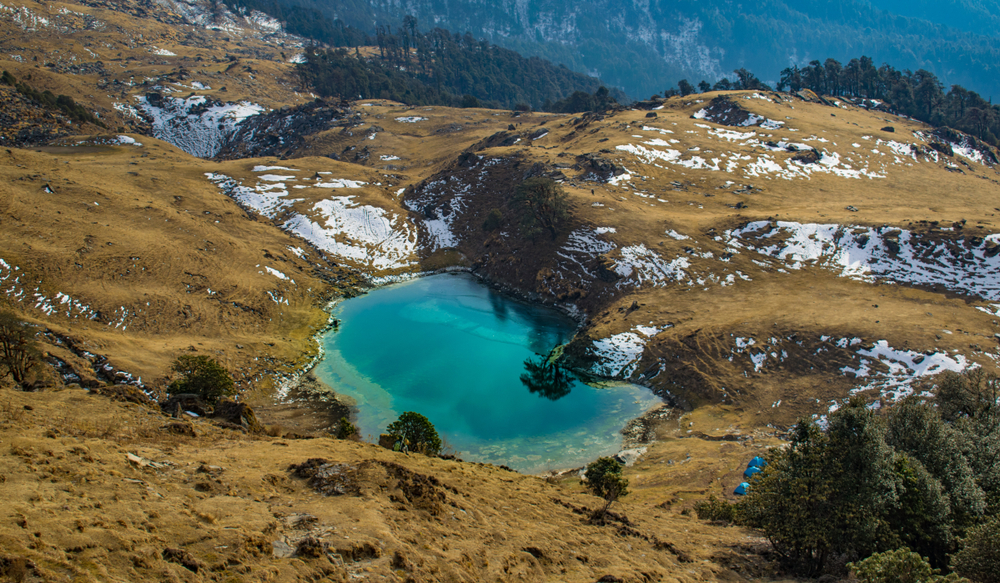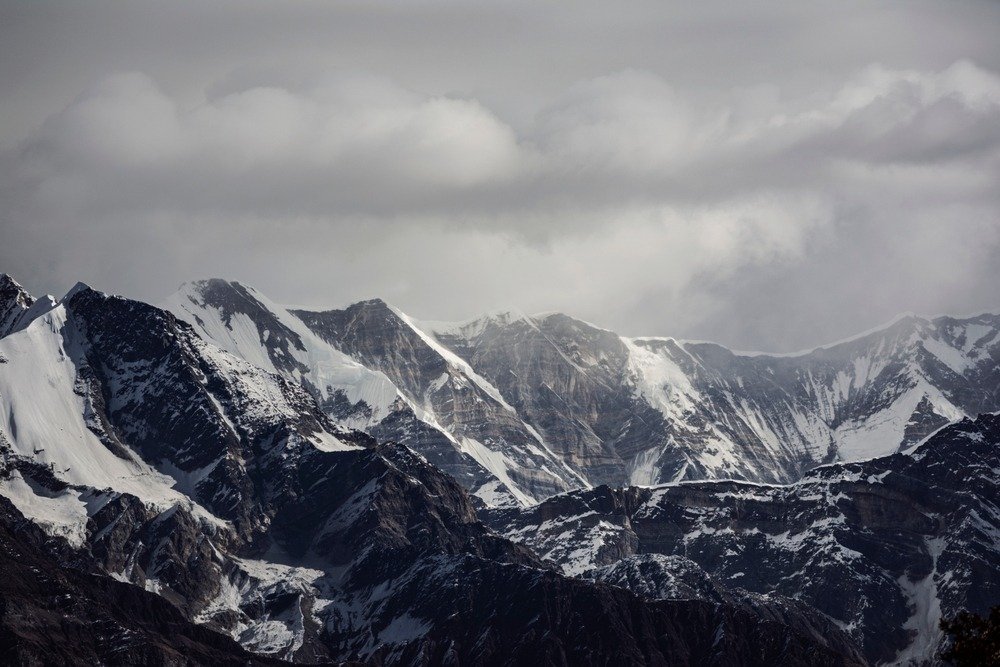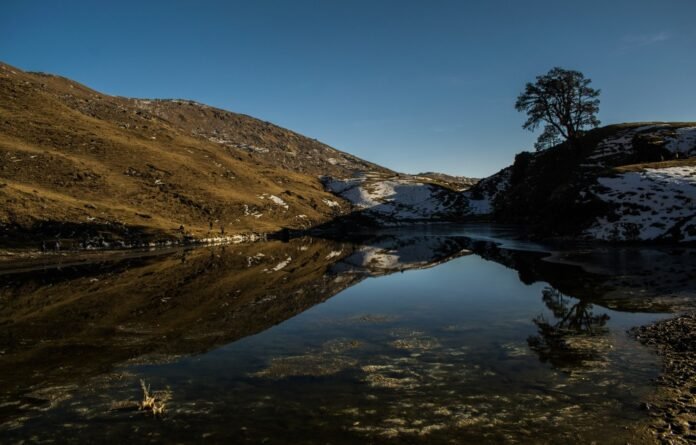Introduction: Why Brahmatal Trek is a Must-Do
I still remember the moment I decided to take on the Brahmatal Trek—scrolling through images of snow-covered trails, crystal-clear lakes, and panoramic views of the Himalayas, I just knew I had to experience it for myself. Fast forward a few months, and there I was, standing at the base of this enchanting trek, filled with excitement and anticipation.
If you’ve ever dreamed of trekking through snow-draped forests, camping under a blanket of stars, and standing at the edge of frozen lakes with the mighty Himalayan peaks as your backdrop, then this trek is for you. Let me walk you through everything you need to know to plan your own Brahmatal adventure—because trust me, you won’t want to miss this!
What Makes Brahmatal Trek So Special?
When I think about Brahmatal, a few things come to mind: endless snowy landscapes, the calm and quiet of a frozen lake, and the towering presence of the mighty Mt. Trishul and Mt. Nanda Ghunti. You don’t get these kinds of views every day, and the fact that this trek is lesser-known makes it feel even more exclusive—like it’s your little secret with the mountains.
The highlight for me? Without a doubt, the stunning Brahmatal Lake. I remember sitting by its frozen surface, feeling like I’d stumbled into a postcard. Legend has it that Lord Brahma meditated by this lake, and while I’m not superstitious, there was definitely a meditative calm in the air that felt magical.
Best Time to Embark on Your Brahmatal Trek Adventure

Yes, particularly if you’re in good physical condition. Now, you might be wondering—when’s the best time to go? If you want to experience Brahmatal in all its snowy glory, plan your trek between December and March. That’s when the snow is thick, the lakes are frozen, and the scenery feels straight out of a winter fairy tale. If you’re looking for a hassle-free and well-organized trek experience, I highly recommend checking out The Searching Souls. They specialize in Himalayan treks like Brahmatal Trek, offering everything from professional guides and cozy campsites to essential trekking gear.
For those of you who prefer slightly warmer weather and vibrant greenery, April to June is also a great time. The snow melts, making way for colorful meadows and clear skies. I personally went in January, and while it was freezing cold, the snowy landscape was everything I had hoped for.
How Challenging is Brahmatal Trek? (Don’t Worry, You’ve Got This!)
Before I went, I asked myself the same question: “Can I actually do this trek?” Yes, especially if your physical condition is good. The Brahmatal Trek is considered moderate in difficulty, which makes it perfect for beginners and seasoned trekkers alike. You’ll be hiking up to an altitude of around 12,200 feet, so it’s no walk in the park—but with some stamina and preparation, it’s totally achievable.
The best part? Even though the climb can get a little steep at times, the pace is manageable, and there’s plenty of time to soak in the views (and catch your breath!).
How to Get to Brahmatal’s Starting Point (AKA the Adventure Before the Adventure)
Getting to Brahmatal’s base camp, Lohajung, is an adventure in itself. I started my journey from Delhi, hopped on a train to Kathgodam, and then took a scenic drive through the twisting mountain roads of Uttarakhand. The views on the way were just a sneak peek of what was to come—lush green valleys, sparkling rivers, and the occasional glimpse of snow-capped peaks in the distance.
If you’re flying, the nearest airport is Pantnagar, and from there, you can either hire a taxi or take a bus to Lohajung. The drive is long but trust me, the views make it all worth it.
What to Pack: My Trekking Essentials for Brahmatal
Packing for Brahmatal is like preparing for a mini expedition. I learned the hard way that layers are your best friend, especially since the temperature can dip below freezing. So, here’s my advice: pack smart, pack light.
- Clothing: Base layers to keep you warm, a fleece jacket for insulation, and a waterproof outer layer to keep the snow out. Don’t forget thermal pants, woolen socks, and gloves—you’ll thank me later.
- Gear: Good trekking shoes with strong grip are non-negotiable. You’ll also want a pair of trekking poles to help you on those steep climbs. And if you’re camping, your trek operator will likely provide the tents and sleeping bags (make sure they’re rated for freezing temperatures!).
- Personal Items: Sunscreen (yep, you can still get sunburned in the snow), a lip balm, and energy snacks to keep you going. Oh, and always carry a first-aid kit—you never know!
My Day-by-Day Brahmatal Trek Itinerary
Here’s how my trek played out, and if you follow this, you’re in for an epic journey:
Day 1: Arriving at Lohajung
After a long but beautiful drive, I arrived at Lohajung, a quiet village nestled in the hills. You’ll spend the night here in a cozy guesthouse, and it’s the perfect time to rest up and mentally prepare for the trek ahead.
Day 2: Lohajung to Bekaltal
This was the day the trek really began. We trekked through oak and rhododendron forests, with a steady climb that wasn’t too tough but got the blood pumping. After about five hours, we reached Bekaltal Lake, surrounded by dense forests and shimmering in the sunlight.
Day 3: Bekaltal to Brahmatal
Day 3 was a winter wonderland dream. The snow became deeper, and the trail took us to Brahmatal Lake—frozen, still, and hauntingly beautiful. Camping near the lake, surrounded by untouched snow, was nothing short of magical.
Day 4: Brahmatal to Summit and Back
The summit day! After an early morning start, we trekked to the highest point, where I was rewarded with jaw-dropping views of Mt. Trishul and Mt. Nanda Ghunti. The feeling of standing at the top, gazing out at the endless sea of snow-covered peaks, was absolutely worth every step.
Day 5: Descend from Brahmatal to Lohajung
After the high of summiting, the descent back to Lohajung felt bittersweet. We retraced our steps, but I couldn’t stop turning back to catch a final glimpse of the mountains.
Day 6: Journey Back Home
The drive back to civilization was a reflective one. I felt both proud and humbled by what I had just experienced. It was the ideal conclusion to an ideal journey.
The Best Moments of My Brahmatal Trek

Looking back, a few moments stand out—like walking across frozen lakes that glistened in the sunlight, or waking up in a tent to the sound of absolute silence, with only the gentle crunch of snow underfoot as I ventured outside into the chilly morning air. But nothing compares to the views at the summit. I still get chills thinking about the experience.
Accommodation Options: Where You’ll Stay Along the Way
Camping under the stars for the majority of the journey adds an element of adventure. The campsites are simple but stunning, nestled amidst forests or next to the lake. If you prefer a bit more comfort, homestays are available in the villages, where you can enjoy some local hospitality.
Should You Go Solo or with a Guide? Here’s My Take
I went with a group led by a local guide, and I can’t recommend it enough. Having a guide not only makes the trek safer, but they also share stories, insights, and cultural tidbits that you’d miss out on if you went solo. However, if you’re an experienced trekker, solo trekking can be a peaceful and liberating experience.
Dealing with Altitude: Don’t Let AMS Spoil the Fun
At high altitudes, Acute Mountain Sickness (AMS) can be a real issue. The key is to acclimatize properly, take it slow, and stay hydrated. The best course of action is to descend to a lower altitude if you begin to feel ill.
Safety Tips for a Smooth Trek
Safety should always be a priority. Stick to the trail, keep warm, and pay attention to weather conditions. Do not hesitate to halt and wait out inclement weather. Additionally, keep an emergency kit handy at all times—it’s better to be safe than sorry!
Respecting Local Culture and Customs
One of the things that made the trek special was the warmth of the locals. We passed through a few remote villages, where the pace of life slows down, and the people greet you with genuine smiles. Always remember to be respectful—these places are their homes, after all.
Leave No Trace: How to Trek Responsibly
I made it a point to follow the Leave No Trace principles. It’s simple—pack out what you pack in, don’t disturb the wildlife, and respect the environment. Brahmatal is too beautiful to be spoiled by careless trekkers.
Conclusion: Brahmatal is Waiting for You
So, if you’re itching for an adventure that offers the best of the Himalayas—stunning views, snowy landscapes, frozen lakes, and a peaceful escape from everyday life—the Brahmatal Trek should be at the top of your list. It’s more than just a trek—it’s an experience that stays with you long after you’ve returned to the hustle and bustle of city life. I came back not only with photos but with memories and a sense of achievement that I’ll treasure forever.
Please Read More Related Topics – How to Prepare for the Dayara Bugyal Trek: A Complete Guide
